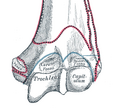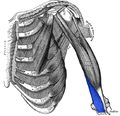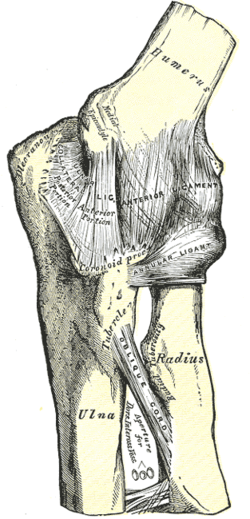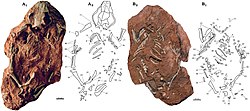(radial fossa, coronoid fossa, and olecranon fossa). As well as its true anatomical neck, the constriction below the greater and lesser tubercles of the humerus...
28 KB (3,218 words) - 17:59, 27 March 2025
the anterior portion of the trochlea is a small depression, the coronoid fossa, which receives the coronoid process of the ulna during flexion of the...
1 KB (90 words) - 16:25, 22 October 2020
inferior to the coronoid fossa anteriorly and to the olecranon fossa posteriorly. In humans, these two fossae, the most prominent in the humerus, are occasionally...
5 KB (619 words) - 18:23, 18 October 2024
forearm is received into the coronoid fossa of the humerus. Its upper surface is smooth, convex, and forms the lower part of the semilunar notch. Its antero-inferior...
5 KB (512 words) - 20:35, 23 May 2025
Ulna (redirect from Head of the ulna)
formed by the olecranon and the coronoid process, and serving as articulation with the trochlea of the humerus. About the middle of either side of this notch...
19 KB (2,303 words) - 10:15, 6 March 2025
Brachialis muscle (category Wikipedia articles incorporating text from the 20th edition of Gray's Anatomy (1918))
of the region known as the cubital fossa (elbow pit). It originates from the anterior aspect of the distal humerus; it inserts onto the tuberosity of...
6 KB (566 words) - 08:05, 21 August 2024
Elbow (redirect from Ligaments of the elbows)
olecranon, the cubital fossa (also called the chelidon, or the elbow pit), and the lateral and the medial epicondyles of the humerus. The elbow joint...
41 KB (4,850 words) - 00:49, 25 May 2025
Dog anatomy (redirect from Skeletal system of the dog)
innervated by the axillary nerve. Infraspinatus: originates on the infraspinatus fossa and inserts on the greater tubercle of the humerus. It acts to extend...
55 KB (6,719 words) - 07:42, 15 February 2025
analogous with the acromion of mammals. adductor fossa The adductor fossa or Meckelian orifice in reptiles and dinosaurs is the major opening into the lower jaw...
160 KB (16,549 words) - 15:47, 23 May 2025
Criminal Minds Let's Roll Clay Moons L-lateral epicondyle R-radial fossa C-coronoid fossa M-medial epicondyle FFNF "Fireman Fight Notorious Fires Flowers...
42 KB (3,618 words) - 14:58, 7 December 2024
Panthera balamoides (category Fossils of Mexico)
and trochlea, the parts of the humerus that articulate with the ulna and radius. The olecranon fossa (depression that articulates with the radius) is located...
22 KB (2,395 words) - 23:57, 22 May 2025
epicondyle of the humerus to the annular ligament. The middle fibers, vertical in direction, pass from the upper part of the coronoid fossa and become...
2 KB (171 words) - 15:56, 14 November 2024
Triisodon (category Paleocene mammals of North America)
posteriorly. The ulna is conspicuously more gracile relative to the humerus, and has a gently convex ventral border. The ulna has a large coronoid process...
12 KB (1,219 words) - 02:40, 1 January 2025
Bone (redirect from Trabeculae of bone)
rigid organ that constitutes part of the skeleton in most vertebrate animals. Bones protect the various other organs of the body, produce red and white blood...
89 KB (10,635 words) - 12:48, 2 June 2025
Diplobune (category Paleogene mammals of Europe)
the lateral lip is "weaker" compared to the preceding Diplobune species. The radial fossa of the humerus is not as marked, but the coronoid fossa of the...
103 KB (11,987 words) - 13:44, 22 May 2025
Pronator teres muscle (category Wikipedia articles incorporating text from the 20th edition of Gray's Anatomy (1918))
the coronoid process of the ulna and inserts near the middle of the radius. The pronator teres has two heads—humeral and ulnar. The humeral head, the...
8 KB (877 words) - 12:02, 23 October 2024
cranial fossa anterior cruciate ligament anterior ethmoidal foramen anterior ethmoidal nerve anterior funiculus anterior horn cells anterior horn of the lateral...
55 KB (4,485 words) - 13:36, 13 February 2025
False potto (category Primates of Africa)
spine on the second neck vertebra, an entepicondylar foramen (an opening in the humerus, or upper arm bone), a lacrimal fossa (a depression in the skull)...
18 KB (2,205 words) - 15:00, 25 January 2024
Radial groove Deltoid tuberosity Condyle of humerus Capitulum Trochlea Olecranon fossa Coronoid fossa Radial fossa Medial epicondyle Lateral epicondyle Radius...
50 KB (4,111 words) - 20:02, 4 April 2025
Cat anatomy (redirect from Deeper muscles of the neck and back (cat))
to the zygomatic arch and fills the temporal fossa of the skull. It arises from the side of the skull and inserts into the coronoid process of the mandible...
49 KB (6,104 words) - 01:05, 9 June 2025
Alagtsavbaatar (category Eocene mammals of Asia)
present. Above the trochlear and capitular articular surfaces are the coronoid fossa and radial fossa respectively. A deep olecranon fossa with a thin wall...
9 KB (1,067 words) - 18:50, 28 May 2025
toothplate, a slender shaped anterior coronoid, and in the loss of the intracranial joint and coronoid fossa. The loss of the intercranial joint was a direct...
20 KB (2,761 words) - 17:09, 19 May 2025
Chuanqilong (category Dinosaurs of China)
nodosaurids, the coronoid eminence projects above the level of the dentary tooth row. Below the coronoid eminence is the large adductor fossa. The retroarticular...
40 KB (4,498 words) - 01:35, 19 May 2025
Akidolestes (category Cretaceous mammals of Asia)
well. On the pectoral girdle, Akidolestes has glenoid fossa smaller than the humeral head, which offer a great range of rotation for the humerus. Moreover...
15 KB (1,561 words) - 23:11, 30 November 2024
This is a table of skeletal muscles of the human anatomy, with muscle counts and other information. Skeletal muscle maps Anterior view Posterior view A...
139 KB (905 words) - 14:56, 30 May 2025
Bagualia (category Dinosaurs of Argentina)
insights into the evolution of Eusauropoda. It exhibits a well-developed acromion process, deeper acromion fossa, and a straight humerus with a low deltopectoral...
20 KB (2,107 words) - 01:17, 6 June 2025
Australopithecus sediba (category Pages using the EasyTimeline extension)
border; and the coronoid process of MH1 is angled towards the back with a deep and asymmetrical mandibular notch, whereas MH2 has an uncurved coronoid process...
54 KB (6,792 words) - 18:26, 23 May 2025
glenoid fossa is deeper and more rounded. The humerus' head articulates with the glenoid cavity of a scapula while its lower end connects with the forearm's...
34 KB (4,454 words) - 18:46, 17 November 2024
Catopsbaatar (category Cretaceous mammals of Asia)
downwards on the inner side of the jaw. The small mental foramen was close to the upper middle margin of the diastema. The coronoid process of the mandible...
49 KB (5,723 words) - 20:51, 30 March 2025
Sima de los Huesos hominins (category Fossils of Spain)
implications for the mobility and structure of the shoulder joint. The glenoid fossa (where the shoulder blade connects with the humerus) is taller and...
92 KB (11,530 words) - 00:47, 10 June 2025






















